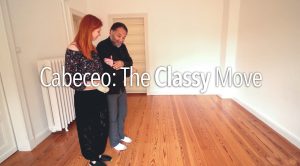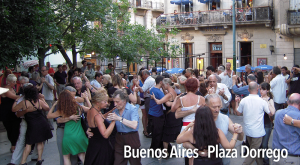(notation: There’s a full article and video on this topic.)
There are lots of really good tango exercises for your feet, your balance, your stability, but there aren’t so many for the couple to practice. Or so you would think. The really obvious ones are 1.) The Molinete Together Exercise. 2.) The No Arms Exercise. and 3.) The Walk Together Exercise.
However more than likely you haven’t considered that there are variations to those ideas, and a few more that you haven’t even considered.
Let’s start with that 1st one: The Molinete Together Exercise. Truthfully that’s the Molinete/Giro Exercise Together. Just because it’s called the Molinete exercise, the Lead tends to think that the Follower has to do all the frakkin’ work. That’s not the case. The reality is the Lead has to do the same amount of work and still work on the same issues only a from a slightly different perspective but it still works for the Lead. An important variation of this exercise is for both parties to engage in the Molinete together, meaning that the Lead will do the Follower’s typical steps with the Follower. And if you’re thinking that there’s no reason in the world for the Lead to do this kind of work. Think again! There’s every reason in the world!!!!!
The next on this list is the No Arms Exercise. This is where the Lead and the Follower attempt to dance without the Embrace. You’re going to think to yourself “WHY ?”. And you’d be right to ask that question. What’s the point of practicing dancing without the use of the Embrace ? That’s it right there. If you can dance without NEEDING the embrace then you’re onto something. Usually, the embrace is the place where 50% of your issues come to the forefront. So what would happen if you removed the embrace component ? You’d start to see the other 50% of your issues that you’re not seeing. So what’s generating that other 50%…your walk! It should be noted that in this exercise, the goal is to walk on the beat, to the pauses, within the phrases. This is WALKING, and nothing more than that. An important variation on a theme with this exercise is to dance with all the vocabulary you can and to watch your anxiety levels as you want to grab onto your partner.
The seemingly last exercise on this list is the Walking Together exercise. You would think that this would be simple, easy. Not. The goal of this exercise is to walk to 40 beats per minute, not more than that. The slower the better. This one will challenge you in ways you haven’t even begun to imagine. You’ll have a want to use your embrace to communicate pushing and pulling to your partner. You’ll have a want to hang on your partner even more. You’ll have a want to engage micro-stabilizations with your hands and more importantly with your fingers. All of that you have to be aware of…and more. Remember this is about walking slowly with your partner. An important variation of this exercise is to halve the BPM to 20! Good luck.
Ok, that does it for the obvious exercises.
What about the not so obvious ?
a.) The Argentine Cross. Did you not see this one coming ? While it may be the most used piece of vocab in Tango, a couple should practice this in open and in close embrace, as well as Parallel System crosses as well as Cross System crosses! 🙂 And if they want to try to take things to next level, they should take a crack at the 256 Variations of the Argentine Cross:
b.) Walking Transitions. A couple should practice the four common walking transitions that are available from Parallel Walking: 1.) PW into Milonguero Ochos. 2.) PW into Traveling Ochos. 3.) PW into Molinete/Giro. and 4.) PW into The Milonguero Turn.
c.) Ocho Transitions. For all the same reasons above, a couple should practice the transition states between Ochos, and the 4 common ones: 1.) Milonguero Ochos into The Milonguero Turn. 2.) Traveling Ochos into The Molinete/Giro. 3.) Milonguero Ochos into the Molinete/Giro. 4.) Traveling Ochos into The Milonguero Turn.
These are just some of the things that a couple should be practicing on a regular basis.
Frequently when we practice, we practice dancing. As if we were on a social dance floor. That’s not the only thing you should be practicing. The stuff above is the interstitial stuff, that stuff that binds that ‘social’ dancing together. Which is to say that it’s the glue that holds everything together, and you absolutely need to practice this stuff religiously.
- Glossary: Milonguero Ocho
- Glossary: Exercise
- Glossary: Argentine Cross
- Glossary: Traveling Ocho
- Glossary: Milonguero Turn
- Glossary: Close Embrace
- Glossary: Vocabulary
- Glossary: Molinete
- Glossary: Embrace
- Glossary: Walking
- Glossary: Pushing
- Glossary: Pulling
- Glossary: Parallel Walking System
- Glossary: Cross
- Glossary: Lead's Giro
- Glossary: Lead
- Glossary: Open Embrace
- Glossary: Ochos











